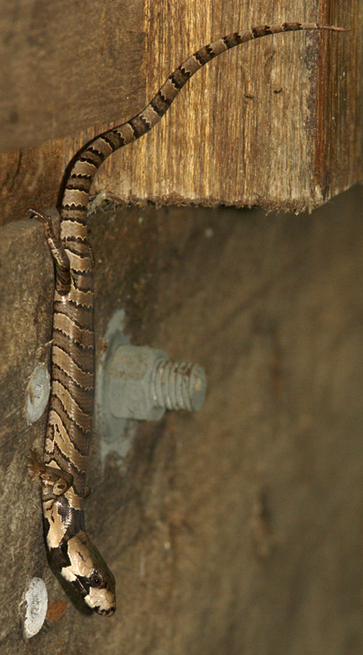
This striking-looking skink is relatively common in local rainforest and damp sclerophyll (eucalypt) forest and is often found in moist areas of the garden, sheltering in leaf litter or in wood piles. It also inhabits garden sheds. It is useful too, as a major part of its diet consists of slugs and snails, so its appearance in the garden should always be welcomed. It will also dine on various insects and, if dog or cat food is left out at night, finds that tasty too. (Both dogs and cats should be restrained at night so ideally this gourmet part of the lizard’s diet will not be available.)
The next surprise is their colour, because the grey-coloured body is marked with wide black cross bands. These dark markings are particularly recognisable in young animals and often fade as they get older, although some adults retain their stripes.
Yet another surprise is in store too, because when it believes it is threatened the pink-tongued skink can put on quite a ferocious display, standing up to make itself look larger and flickering its tongue, not unlike a snake – a useful threat mechanism. It also sometimes makes a hissing sound.
Despite its name, its mouth and tongue are blue in juveniles, turning to pink after about three months.
The pink-tongued skink is closely related to the blue-tongued lizard or Eastern blue-tongue

With all these surprises, it is easy to imagine why the habits of pink-tongued skinks have been well studied.
They give birth in early summer, and the female moves through grass or undergrowth during the birth process, giving each new arrival as non-threatening and non-competitive a start as possible. This they need, as they are independent from birth, with their first job being to consume the foetal membrane and the second to start catching slugs or snails! Like all young creatures they are entering a dangerous world, and it is only a lucky few which make adulthood – at approximately 22 months – without being eaten or killed.
However, usefully they are not confined to the ground and can climb trees to escape danger or catch food. The long tail is prehensile, and is used when climbing.
Up here, especially in forested surrounds, it is not unusual for skinks to come indoors and friends of ours are regularly “visited” by the pink-tongues. Their presence often demands extra vigilance, because their climbing habit can get them into trouble as they can slide into containers, for example, from which they cannot escape and may die a slow, lingering death.
They do not seem unfriendly, our friends say, but they have not noticed them since Cyclone Yasi.
It will be interesting to see if they turn up again.
With flowers in gardens again, bees and other insects are busy.
Wildwatch was surprised the other day when an enormous carpenter bee buzzed past. It was searching for nectar first in purple flowers then, when spotted again a few hours later, working through bright yellow tecoma flowers.
These big, aeroplane-shaped bees are always fascinating to watch, and the heavy drone, apparently produced by the females, as they fly is quite arresting.
Unlike honey bees, whose workers measure 12-14mm long, carpenter bees measure in at an eye-catching 20-25mm. The females are black with yellow hair on their face and thorax, and even the wings are grey and thick-looking.
Males have yellow hair all over their body.
Solitary bees, the females excavate tunnels in wood to lay their eggs.
+++


